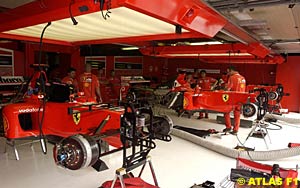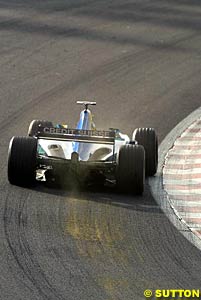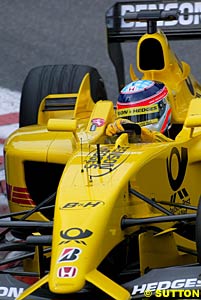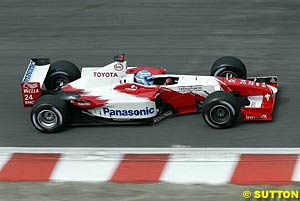
Atlas F1 Technical Writer
The Belgian Grand Prix might have offered little racing action for the fans, but it provided many discussion points for the technically-savvy enthusiasts. From the grounding effects to the various revised aero parts, Craig Scarborough reviews the cars as well as the teams' weekend
Otherwise, the threatening clouds never brought rain and the warm to hot conditions suited the Michelin tyre runners much more than the Bridgestone runners, with the usual exception of Ferrari.
Although the rain never made it to the track surface, advertising slogans painted on the track lead the drivers to complain about the loss of grip and the paint was removed overnight, before Sunday, to comply with the driver's request.
Grounding
More than almost any other track, Spa sees the cars grounding out on the track. The bumpy road surface; the changes in gradient through Eau Rouge; and the huge level of downforce squashing the cars to the track in the high-speed corners - all these reduce the gap between the car and the track to zero.
One problem with a flat underbody and no ground clearance regulations, though, was that the flow of air to the diffuser would stop if the car grounded too much. This would choke the diffuser and immediately rid the car of the downforce created by the diffuser and make the car slide off the track. And in fact, this problem was believed to be a factor in Ayrton Senna's fatal accident at Imola in 1994.
The FIA reacted in two ways: first, by adding a step that runs along the length of the car to the underside of it, effectively raising the bottom of the sidepods and splitting the floor into two levels. This would prevent the entire underfloor from choking and also reduce the maximum downforce possible from the diffuser.
The second solution was to add a plank under the lower central section of the floor, that would reveal if the car grounded too much. Thereafter, skid block wear was limited in size and placement and would be scrutineered for excessive wear.
Both these rules proved to be successful in limiting ground clearance, and Michael Schumacher, for example, lost his win at Spa in 1994 because of excessive wear.
Furthermore, at Spa this year the cloud of brown dust thrown up from the wooden plank under the car gave evidence that the teams still strive to run the cars as low as possible, but never so low as to cause the car any instability.
Team by team
Ferrari
The F2002 was dialled in and working well straight away at Spa, despite detail changes to the track layout. On Friday, Michael Schumacher was totally happy with the car whereas Rubens Barrichello felt more fettling was needed.
In qualifying, Schumacher carried out two timed runs as well as one he had to abort due to Olivier Panis's oil on track. When he went out for his fourth and last run, he was too late to complete the installation lap laps before the flag went out and was unable to finalise a timed lap, in order to assess a set up change.
Barrichello in turn said the car was not quite balanced, "giving me understeer and oversteer in the same corner." Improvements were made to the car and his third on the grid gave him the clean side of the track to make a good start from.
With a clean start for Schumacher, he minded his tyres for a few laps and settled in to a pace beyond all those around him. He was able to ease up towards the end to preserve the car.
Barrichello stared the race in the spare car, as he preferred its handling, yet he was slower than Schumacher, in part because he was running on the harder Bridgestone tyres.
Williams
On Friday, Ralf Schumacher was happy with car but wanted to play with the set up to gain more pace. Juan Pablo Montoya was less happy but concentrated on making a tyre choice on heavy fuel rather than improving the set up. This resulted in the Williams handling looking very nervous and saw Montoya go off the track several times in the two Friday sessions.
At the end of the first session he suffered a gearbox problem, which - according to Patrick Head - was a "hardware" problem and not an electronic one, necessitating a change of the unit between sessions and delaying Montoya slightly in the second session as the work was completed.
During qualifying the team continued to struggle with getting heat into the tyres and subsequently suffered pace reduction. Montoya was able to overtake Kimi Raikkonen's McLaren on the second lap of the race, and come the pitstops - despite changes being made to the car's set up - he was able to maintain his position ahead of the Finn with a quicker stop.
David Coulthard pushed Montoya towards the end of race but was held off for third place. Ralf struggled yet again with the car's handling, resulting in a spun on his "in-lap" for his pitstop, then pressing the wrong button on the steering wheel to exit the pits and struggling to pull away. Nevertheless, Ralf remained reliable to finish in fifth with two points.
McLaren
McLaren brought out the Canadian Grand Prix's spec two-element front wing for Spa, replacing the three-element set-up used at all the other races this year. The wing provides a lower range of downforce settings and does so with much less drag than the triple wing would for the same downforce.
Typical of McLaren's approach to a race weekend this year, the team topped the Friday time sheets as part of the preparation for the weekend, despite the fact that Kimi Raikkonen had a small hydraulic problem between the sessions.
Having decided to split their tyre choice, Raikkonen opted for the softer Michelin and this propelled him to second on the grid. David Coulthard meanwhile lost more time in the middle sector and expected a better performance from the tyres in the race.
Any advantage of Raikkonen's front row start was lost when Barrichello was able to squeeze past at the start. A few corners later he also lost out to Juan Pablo Montoya and was finally overtaken in the pitstop sequence by teammate Coulthard, who eventually finished fourth. Moreover, before his second stop his Mercedes engine let go, ending an all around poor race.
Renault
The Renault drivers were fairly happy after Friday but admitted more work was needed to get better lap times from the car.
Qualifying produced a mixed result, with Jenson Button going the wrong way with a lower downforce set-up and dropping down to tenth, while Jarno Trulli made it up to seventh despite only using three runs.
The race looked promising on the Michelin tyres, but as usual this year, it soon fell apart. At the start Trulli tried to go around the outside at La Source and slid wide and inexplicably hit the neutral button on the steering wheel, losing ground while he got going again.
Nevertheless, the Italian benefited from Ralf Schumacher's spin only to lose his engine just eight laps from the finish. Meanwhile, Button had already been long gone with an engine failure on lap twelve.
Sauber
Sauber were lost during Friday's session languishing at the back of grid. Both drivers reported nervous handling and Felipe Massa described the understeer in the slower corners as "massive".
The pattern continued in qualifying - one of the team's worst in recent times. Massa now had snap oversteer joining the reoccurring nervousness and understeer, and the team investigated aerodynamic solutions to the handling problem, but to no avail. Concluding the problem was chassis related, they also worked on damper and other mechanical set-up options to rid the car of the nervousness.
For the race, the car's handling had been improved and Massa - on a different fuel strategy than Nick Heidfeld - was able to pass both his teammate and Allan McNish until his engine failed coming past the pits. Heidfeld also enjoyed the better handling and better reliability and was able to make it to the finish in tenth.
Jordan
Jordan arrived to Spa with a relatively normal low-medium downforce configuration, but there was some experimentation with the aerodynamic detailing around the front suspension.
Another tiny detail - emphasising Jordan's continued aero development - is the vertical lip on the edge of the floor between the rear wheels. This is usually a flat triangular shape, but now curved inwards to shape the flow off the edge of the flat part of the floor.
In all, a weekend that was predicted to be good for Jordan ended in disappointment. As far back as Friday's practice, Fisichella reported trouble with the rear dampers and nervous handling, while Sato also suffered one of the many Honda engine failures, losing the team valuable set-up time in an already shortened session.
This lack of set-up time showed in qualifying, when Fisichella went off the track due to locked brakes and switched to the spare car. Sato had less problems but still found the car nervous to drive.
Mechanical maladies occurred in the race, with Fisichella having one of the more spectacular Honda engine failures. Sato in turn was delayed in his pitstop with a recalcitrant wheel nut and nervous handling, but kept the car on the road to finish the race the last of the runners, in eleventh.
BAR
BAR, as Jordan, suffered terribly with the latest spec Honda engine, but regardless the drivers were happy with the handling - if not the lap times - it produced.
Although not necessarily new for Spa, new bargeboards were seen on the BAR. Since the Williams-inspired aero update, the car has carried forward-placed bargeboards, which were initially simple one-piece curved panels and are now more complicated, with a extra aerofoil section leading the main board. This mirrors the set-up Williams have raced with all year.
In qualifying, Villeneuve's set-up wasn't perfected from the morning session and spun on one of his runs. Nevertheless, he was able to engage reverse and keep motoring backwards out of the gravel trap.
Fifteenth on the grid was welcomed by Panis, as his run of engine failures continued with yet another blow up in the timed session. He then had to wait while the T-car was switched to his settings only to suffer a misfire on that engine as well.
Filled up with Fuel, Panis got a poor start to the race and battled to catch up with his teammate, but another huge engine failure cost him a finish. Villeneuve too was on form in the race and battled from a poor start to bring the car home in eighth.
Jaguar
With a new front suspension tested in a brief shakedown at Silverstone, Jaguar found themselves unexpectedly competitive at Spa, plus the Michelin tyres were also better suited to the car over the weekend.
The shortened Friday sessions were interrupted with minor technical glitches such as misfires, brake and throttle pedal problems. The qualifying session produced no such repeats and only driver errors blighted Pedro de la Rosa's last two runs to leave him just outside the top ten. A clean session from Eddie Irvine found him in a season-best eighth place.
Irvine's trouble-free and competitive run continued in the race with a drive that involved fighting off the Toyota of Mika Salo. He finished in sixth place and brought a welcomed point for the team.
Pedro de la Rosa ran a few places behind his teammate, only to suffer a rear suspension failure, which resulted in a bumpy but harmless ride across the grass.
Toyota
The team found the chassis suited to the track on its Michelin tyres and the engine was also able to show its speed, especially with the updated spec engine in qualifying.
The Friday and Saturday sessions went without a hitch and the resulting ninth and thirteenth grid positions were a just reward for the team. In the race, both drivers were able to fight with their rivals, and the only technical problem was a wheel sensor failing on Allan McNish's car, upsetting the traction control. Salo and McNish both finished seventh and ninth respectively.
Minardi
When Anthony Davidson ended up eighteenth fastest out of 20 runners on Friday, the result showed the driver's potential but was also flattered by Mark Webber's problems in both sessions - with a front end problem in the opening session and then gearbox troubles in the second.
The drivers' fortunes were reversed on Saturday. Webber was in nineteenth spot after losing time with gearbox trouble in the morning session; Davidson had a clear run and finished last but only six tenths behind his teammate.
Webber suffered gearbox troubles in the race, forcing him to retire after only five laps and leaving Davidson to chase the faster Jordan of Takuma Sato until he went into to the fast Pouhon corner too quick and understeered off into the gravel to retire.
Spa-Francorchamps - with its daunting fast corners, floor-grinding climbs and gearbox-breaking slow corners - is a tough test for the Formula One car. This proved no different this year, with the teams struggling to obtain handling and reliability. Many fine race drives were ended by engine blow-ups - most of which were from the Honda camp and were catastrophic failures leading to spectacular, fiery retirements. Honda had five (two for Jordan, three for BAR) major engine failures, amounting to almost a quarter of the engines usually used at a weekend.
 Weather played a smaller role last weekend and not in the usual manner: fog around the hillsides on Friday morning did not allow the medical helicopter to take off and therefore the first session was delayed and shortened by half to thirty minutes. This had the effect of greatly reducing the amount of time the teams had to set the cars up and evaluate tyres. It also reduced the gap between sessions which in turn delayed some drivers from going out in the second session, as repairs were still being made to the cars.
Weather played a smaller role last weekend and not in the usual manner: fog around the hillsides on Friday morning did not allow the medical helicopter to take off and therefore the first session was delayed and shortened by half to thirty minutes. This had the effect of greatly reducing the amount of time the teams had to set the cars up and evaluate tyres. It also reduced the gap between sessions which in turn delayed some drivers from going out in the second session, as repairs were still being made to the cars.
 In the eighties and early nineties the cars were run as low as possible to make the most efficient use of the underbody and diffuser, and there were no rules to prevent this as the FIA saw no problem with the practice. Furthermore, the sparks thrown up from the metal skid blocks under the cars made for exciting TV.
In the eighties and early nineties the cars were run as low as possible to make the most efficient use of the underbody and diffuser, and there were no rules to prevent this as the FIA saw no problem with the practice. Furthermore, the sparks thrown up from the metal skid blocks under the cars made for exciting TV.
 The sessions included the usual tyre comparisons on heavy fuel loads, and Barrichello went off the track towards the end of the second session as he was pushing the car too far.
The sessions included the usual tyre comparisons on heavy fuel loads, and Barrichello went off the track towards the end of the second session as he was pushing the car too far.
 McLaren were also constantly seen running in the Friday practice session with the fuel flap open, and according to team boss Ron Dennis this was due to the flap being secured magnetically in these sessions, rather than the mechanical opener installed for pitstops in the race. Over enthusiastic running over the sawtooth kerbs shook the flap open, but otherwise caused no problems to the car.
McLaren were also constantly seen running in the Friday practice session with the fuel flap open, and according to team boss Ron Dennis this was due to the flap being secured magnetically in these sessions, rather than the mechanical opener installed for pitstops in the race. Over enthusiastic running over the sawtooth kerbs shook the flap open, but otherwise caused no problems to the car.
 After the developmental exhaust layout seen in Hungary, Sauber resorted to the older periscope layout for Spa but retained the two layer bargeboards. This suggests the fairing over the exhausts were primarily for cooling and not an engine or aerodynamic performance aid.
After the developmental exhaust layout seen in Hungary, Sauber resorted to the older periscope layout for Spa but retained the two layer bargeboards. This suggests the fairing over the exhausts were primarily for cooling and not an engine or aerodynamic performance aid.
 Giancarlo Fisichella's car had a large cover over the top of the pushrod, where it meets the side of the chassis. Takuma Sato's car didn't sport this development but had a small horizontal fin - which was placed within the "V" of the upper wishbone that also served to clean up the airflow over the centre car. Otherwise, both cars appeared to run the same wings and bargeboards.
Giancarlo Fisichella's car had a large cover over the top of the pushrod, where it meets the side of the chassis. Takuma Sato's car didn't sport this development but had a small horizontal fin - which was placed within the "V" of the upper wishbone that also served to clean up the airflow over the centre car. Otherwise, both cars appeared to run the same wings and bargeboards.
 Friday brought a massive engine failure for Olivier Panis at the end of the shortened opening session, but the team were able to change the engine in double quick time in order allow the Frenchman to get some running in the second session. Jacques Villeneuve had a gearbox fluid leak and lost some time, but he was overall happy in comparison to his previous years at Spa in the BAR.
Friday brought a massive engine failure for Olivier Panis at the end of the shortened opening session, but the team were able to change the engine in double quick time in order allow the Frenchman to get some running in the second session. Jacques Villeneuve had a gearbox fluid leak and lost some time, but he was overall happy in comparison to his previous years at Spa in the BAR.
 The new front suspension was altered only in its geometry and the actual wishbones were visibly different from the previous set-up. The new set-up proved to be successful and both drivers reported improvements, however they also had trouble with the feel from the power steering.
The new front suspension was altered only in its geometry and the actual wishbones were visibly different from the previous set-up. The new set-up proved to be successful and both drivers reported improvements, however they also had trouble with the feel from the power steering.
 One small detail altered for Spa was an additional cooling outlet, opened up along the lower edge of the coke bottle shape. This louvered outlet was also seen on the 2001 test car.
One small detail altered for Spa was an additional cooling outlet, opened up along the lower edge of the coke bottle shape. This louvered outlet was also seen on the 2001 test car.
Please Contact Us for permission to republish this or any other material from Atlas F1.
|
Volume 8, Issue 36
Articles
Schumacher's Living Room
Pummeled by Perfection
Ann Bradshaw: View from the Paddock
Belgian GP Review
The 2002 Belgian GP Review
Technical Review: Belgian GP
Rude Awakening
The Best of Williams
Stats Center
Qualifying Differentials
SuperStats
Charts Center
Columns
Season Strokes
Elsewhere in Racing
The Grapevine
> Homepage |